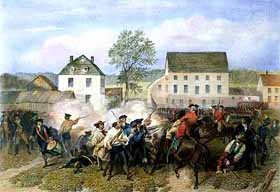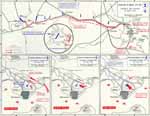Colonial Wars |
American Wars |
Link To This Page — Contact Us —
The Battle of Concord
April 19, 1775 at Concord, Massachusetts
 |
||||||
|
On April 19, The militia had marched for about a mile or so before they saw the Regulars coming. They halted and held position until the British were within 100 rods and then they turned around and marched ahead of the British back toward Concord.
At 7:00 A.M., Col. James Barrett and Maj. John Buttrick, Barrett's second-in-command, kept the Concord militia just out of reach, moving from ridge to ridge before the British. They withdrew through the town to another ridge and held a council-of-war. They decided to withdraw across the North Bridge.
Barrett and his militia watched from the west side of the river as the British entered Concord. Lt. Col. Francis Smith, the commander of the British expedition, assigned the task of securing the town to the grenadiers. He sent 1 company of light infantry to secure the South Bridge and 7 companies to the North Bridge. He chose to remain with the grenadiers in the town and kept Pitcairn, his second-in-command, with him.
The grenadiers peacefully went about searching for the supplies accumulated by the Massachusetts Provincial Congress for the provincial army. However, in their impatience, they did a poor job of destroying the supplies. They threw barrels of flour and musket balls into the pond where both were easily recovered by the locals the next day. Aside from 3 24-lb. cannon that were found and destroyed, the townspeople had 3 days to remove much of the supplies to other towns.
At the North Bridge, Parson was in command of 7 companies of light infantry, a total of 196 soldiers. There were about 400 provincial militia on the nearby ridge. He left 1 company on the west side of the bridge. Two more companies were placed about a 1/4 mile away, commanded by Capt. Walter Laurie. He then took the other 4 companies and marched to Barrett's Farm to seize ammunition and supplies as ordered by Smith.
When the militia began to see smoke rising from town as the grenadiers burned captured supplies, they worried that the British were going to burn the town. They decided to move into action. They held a council-of-war and decided to march back across the bridge into town to prevent its destruction. Barrett ordered the militia to not fire until fired upon by the British Regulars, then "to fire as fast as we could." The militia began to to approach the lone company at the bridge. After a conference between the junior officers, now left in command of the situation at the North Bridge, the other 2 companies moved back to join the third at the bridge.

The militia closed to within 300 yards of the North Bridge and the 3 companies of British light infantry. A messenger was sent into town to inform Smith of the situation. He returned with word that Smith was sending some reinforcements. With the militia continuing to close in, the British retreated back across the bridge to the east side. They did not have time to properly form lines of defense.
The militia that was bearing down on them was commanded by Barrett. It was made up of 6 companies: 2 from Concord, and 1 each from Bedford, Lincoln, Acton and Carlisle. Individual minutemen also came from Westford, Chelmsford and Littleton. As they closed in, the British could not completely form up and then the firing started, most likely from the British. The militia returned fire. The British returned with scattered fire and began an undisciplined retreat back to Concord.
Halfway back to Concord, they met Smith, leading a company of grenadiers. He was too late, so they wheeled around and marched back into Concord. The militia remained by the bridge, lining a stone wall along the road. When Parsons and his 4 light infantry companies returned from Barrett's farm, they were unmolested by the militia and were startled by the sight of the dead and wounded still left at the bridge.
Smith remained in Concord for another 2 hours. Unaware of the events back in Concord, Parason had taken his time returning from Barrett's Farm. The provincials did nothing except to find themselves something to eat. Barrett did not even call his officers together for consultation. Smith probably delayed in Concord in hopes of having the reinforcements that he had requested hours before reach him before he had to begin the march back.
Around noon, Smith and the British made final preparations for a return march. The wounded were taken to local doctors, since there wasn't any army surgeons that had accompanied the expedition. The walking wounded lined up in the middle of the columns and some 4 hours after they entered the town, they set out from Concord. The militia that had been at the North Bridge as well as another hundred that had turned out from nearby towns had congretated at Meriam's Corner where the Lexington and Bedford roads forked. They fired upon the British column as it crossed a narrow bridge nearby. This began an incessant fire on the British force that continued along the entire route.
As they neared Lexington, the British were running out of ammunition and just plain running in some instatnces. Morale and discipline were all but gone. Then a cannonball crashed into the Lexington meetinghouse. Lord Percy was on the Boston side of the Common with the reinforcements. Through a set of staff errors, the reinforcements had not left Boston until after 9:00 A.M., even though Lt. Gen. Thomas Gage had issued the orders at 4:00 A.M.
It was about 2:30 P.M. when Percy's relief force made contact with Smith's expedition at Lexington Common, where hostilities had begun 8 hours earlier.. Percy used his field artillery to keep the militia at a distance while the wounded were tended to and Smith's men were given a rest. At approximately 3:45 P.M., the entire British force was ready to get under way.
Maj. Gen. William Heath had arrived to assume command of the provincial forces. Dr. Joseph Warren, the Boston local that had sent William Dawes and Paul Revere to warn the countryside the night before, also arrived with Heath to join the militia at Lexington. Warren had received word of firing at Lexington Common 8 hours before. He had followed Percy's force to Menotomy where he joined the Committee of Public Safety.
Flanking parties and occassional cannon fire by the British Regulars were sometimes effective in reducing the militia firing. Four hours after leaving Lexington, Percy's force reached Charlestown at 8:00 P.M., having enduried the militia firing upon them nearly the entire route. Once in Charlestown, they were protected by the ships anchored in Boston Harbor.
While the British reached the safety of Boston that evening, they would not leave again until they evacuated the city a year later. A ring of nearly 6,000 militia and American minutemen began to turn out to encircle the city and the Siege of Boston had begun.
On April 20, Warren set up a headquarters in Cambridge and took control of the political aspects of the events of the previous day. Gen. Artemas Ward took military command of the miliita companies surrounding Boston.
The colonists were stunned by their success. No one had actually believed each side would shoot and kill each other. Some advanced; many more retreated; and some went home to see to the safety of their homes and families. Colonel Barrett eventually began to recover control and chose to divide his forces. He moved the militia back to the hilltop 300 yards away and sent Major Buttrick with the Minutemen across the bridge to a defensive position on a hill behind a stone wall.
Smith, leader of the British expedition, heard the exchange of fire from his position in the town moments after he had received a request for reinforcements from Laurie. Smith assembled two companies of grenadiers to lead towards the North Bridge himself. As these troops marched, they met the shattered remnants of the three light infantry companies running towards them. Smith was concerned about the four companies which had been at Barrett's. Their route to return safely was now gone. Then he saw the Minutemen in the distance behind their wall, and he halted his two companies and moved forward with only his officers to take a closer look.
In the written words of a Minuteman behind that wall: "If we had fired, I believe we could have killed all most every officer there was in the front, but we had no orders to fire and there wasn't a gun fired." During this tense standoff of about 10 minutes, a mentally ill local man wandered through both sides selling hard cider. Smith returned his grenadiers to the town and hoped for the best for the remaining four companies.
These men, unaware of what had happened, marched back from their fruitless search of Barrett's farm. They passed unharmed by Barrett's militia on the muster field and through the tiny battlefield, saw dead and wounded comrades lying on the bridge, including one who looked to them as if he had been scalped, which angered and shocked the British soldiers. They then passed sullenly over the bridge, unharmed by Buttrick's Minutemen. The regulars all returned to the town by 10:30 a.m. Even after a small skirmish, and with superior forces, the British colonists still did not fire yet unless fired upon, and this time the regulars did nothing to provoke them. The British Army continued to destroy colonial military supplies in the town, ate lunch, reassembled for marching, then left Concord after noon.
